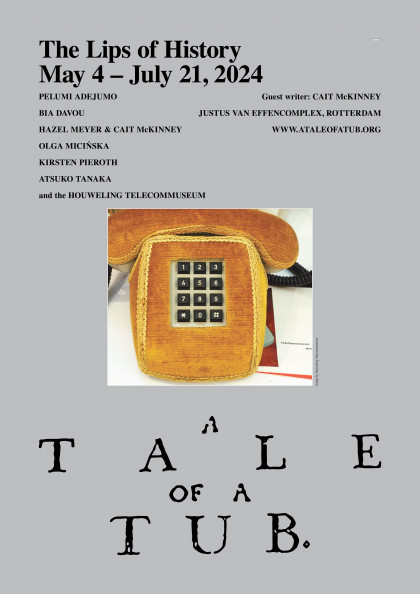
Installation view of The Lips of History. Photo: Gunnar Meier.
The Lips of History
May 4 – July 21, 2024
PELUMI ADEJUMO
BIA DAVOU
HAZEL MEYER & CAIT McKINNEY
OLGA MICIŃSKA
KIRSTEN PIEROTH
ATSUKO TANAKA
and the HOUWELING TELECOMMUSEUM
Guest writer: CAIT McKINNEY
With the soft buzz of radio static in the background, A Tale of A Tub opens The Lips of History—an exhibition transmitting various histories and untold tales of telecommunications. Forming the backbone of this story, are materials, objects and machines on loan from the Houweling Telecommuseum—a small volunteer-run museum in the north of Rotterdam housed in a former telephone exchange, whose collection spans telecommunications from 1880 to 2010. Then, intertwined throughout the exhibition, as cables do, are contributions both newly commissioned and pre-existing from six artists and duos who are, in one way or another, busy with navigating and interrogating the networks and inventions responsible for the distribution of language, image and sound. From subversive interferences to abstract interceptions and censorship-evading inscriptions, The Lips of History is both a speculative and informational retelling of the advent of mass communication—and the ways in which this supposed ‘public’ utility has determined who gets to speak, and when.
With A Tale of A Tub located some mere metres from Marconiplein—a public square named after the man credited with inventing the radio—this focus on communication technologies brings with it the chance for us to reconsider our own modes of communication, given that this exhibition marks the first project of the new directorship. As such, and as a newly established staple of the forthcoming program, we are additionally excited to launch our quarterly bulletin. The bulletins will be a vehicle for a corresponding writing program, through which people from a range of professional and personal backgrounds will be invited to write the exhibition text for each project—and to do so through the prism of their own research and experience, rather than as a direct reflection on or explanation of the project in question. Our bulletins will be distributed to the surrounding neighbourhood and available in the space, doubling as both a place for the community to meet and as a revised take on the standard exhibition text format. As the inaugural contributor, artist and academic Cait McKinney reflects on the role of the telephone—its operators and activators—to plot out its significance within feminist and queer networks of self-organisation and expression.
Events
Saturday, May 4, 2024, 5:00 – 8:00 PM
Exhibition Opening: The Lips of History
Friday, May 17, 2024, 4:00 – 6:00 PM
(Soma)tic Poetry Workshop with CACONRAD
Sunday, June 23, 2024, 2:00 PM
Artist talk with OLGA MINCIŃSKA and HARRIET ROSE MORLEY
Tuesday, July 2, 2024, 2:30 PM
Guided Tour of the HOUWELING TELECOMMUSEUM with PELUMI ADEJUMO and ARNOLD ABELS
Biographies
PELUMI ADEJUMO is a Nigerian-Dutch runaway pastor’s child, interdisciplinary writer, and lucid dreamer. They publish poetry, create performances and music, sometimes in collaboration with the collective Public Relations. Their work is strongly influenced by West-African spirituality and mythology, incorporating both Christian and Yoruba influences, as well as queer and feminist theory. Working with themes such as migratory grief, the grammar of the ‘poor’ and researching the role and reclamation of spirituality in queer lives, they understand language also as a place of struggle. Using unintelligibility and the mix-match of languages to open up disruptive creative and musical possibilities.
Born in Athens, BIA DAVOU (1932–1996) initially began with painting abstract expressionist compositions, before moving towards creating a new form of language communication in the 1970s, one based on the codes of science and technology. Her later works were developed through a laborious process that combined manual handicraft and industrial manufacture.
HAZEL MEYER is an artist who works with installation, performance, and text to investigate the relationships between sexuality, infrastructure, and material culture. CAIT McKINNEY is a media historian interested in how queer social movements use digital technologies to share information. Hazel and Cait have been collaborating since 2014 and presently live in Vancouver, Canada, on the unceded traditional territories of the xʷməθkwəy̓əm, Skwxwú7mesh and Səl̓ílwətaɬ Nations.
OLGA MINCIŃSKA is a visual artist living in Amsterdam. She is a graduate of the MA Art Praxis programme at the Dutch Art Institute, and holds an MFA in Sculpture from the Academy of Fine Arts in Warsaw. Micińska also trained as a woodworker. In 2021 she initiated The Building Institute (TBI), a non-formal platform supporting women and femme folk in the field of construction work.
KIRSTEN PIEROTH ( 1970, Offenbach am Main) lives and works in Berlin. In her work, Pieroth uses everyday objects, situations and activities, isolates them from their original settings and inserts them into a different context. This transfer causes an irritation in the interpretation of perception: individual things, which we usually identify according to their form, function, or use, no longer offer this habitual perspective ascribed to them, but instead refer to multiplied readings, strange systems of reference, and absurd chains of association.
ATSUKO TANAKA (1932, Osaka) was a key artist of the Japanese avant-garde movement Gutai. In the 1950s and 60s, this artistic association appeared as an assembly of abstract painters who used new supports and materials for their creations. Among other works, Tanaka produced a series of costumes for the Gutai group’s theatrical performances, including the Denkifuku dress [Electric garment] in 1956, made from electric light bulbs and flashing light tubes, which she wore to the opening of the second Gutai exhibition. This piece represents one of the first examples of the use of electricity in art, and the preparatory diagrams for her light garments foreshadowed a pictorial approach in which the electric circuit and lights were replaced by coloured circles and lines, evolving towards geometric abstraction.
Housed in an industrial building and telephone exchange dating from 1923, the HOUWELING TELECOMMUSEUM is a unique museum in the north of Rotterdam that manages, conserves and above all shows, hears and smells the history of PTT—the Dutch state company responsible for the post, telegraphy and telephony—and KPN—the current-day supplier of telecommunications to the Netherlands. The museum spans the history of telecommunications from 1880 to 2010 and is run by twenty-five enthusiastic and committed volunteers—all former PTT and KPN employees.
Support
This exhibition came to be thanks to Arnold Abels, Frank Muller and all the volunteers at the Houweling Telecommuseum; EMST, Athens; Fondazione Mudima, Milan; Gary van Niks; Nieuwe Instituut, Rotterdam; and Radio Athènes, Athens. It was made possible with the support of the Mondriaan Fonds and Gemeente Rotterdam.
Olga Micińska’s work was made with help of Maria Ostaszewska-Cichocka and Sophia Simensk. The sound editing of Pelumi Adejumo’s work was done in collaboration with Ari van Vliet Lieke and was voiced by Lieke Tijink and tèmítáyọ̀.
Listening in
CAIT MCKINNEY
My mother, who was otherwise busy working and taking care of three kids, spent hours on the phone some weekends catching up with an old friend. This was the early 1990s so she used the landline in our house: a recently upgraded cordless handset kept in the kitchen. I used to stay nearby, out of sight but within earshot, so I could listen in. It seemed like the phone transformed my mother into a different sort of person, one with concerns, desires, and inside jokes that predated me and extended beyond our family life. Her telephone talk with other women felt conspiratorial and beyond the grasps of me and my sisters, who wanted all her attention and labour, but couldn’t have it for those precious hours she carved out to talk on the phone. My mother busied herself with other, mindless things during the call: cleaning the kitchen, starting on dinner, whatever. But her focus was always with this small group of women she kept in touch with by telephone. The phone made her more than my mother: a woman with a past and present network I could eavesdrop on but didn’t totally understand.
As a technology that connects people over a distance, voice-to-voice, from one semi-private, domestic space to another, the telephone has long offered stealthy ways for women to episodically escape the social hierarchies defining their lives. Feminist media studies scholar Lana Rakow writes, ‘If we are genuinely interested in learning how gender differences are carried out in and through communication technologies, clearly we must investigate the uses of the telephone. Also, even more than other technologies, the telephone must be examined in relationship to the network of people it holds together.’ [1] The telephone’s influence on drawing networks of women together extends beyond the individual in her home, to how telephone talk organizes labor and outreach.
Think, for example of the switchboard operator, sitting at a bank of desks alongside dozens of other clerical workers, routing calls through the telephone company’s network using a maze of cables and plugs laid out in front of her. Before the introduction of automatic routing in the 1940s, operators followed instructions from callers about how to direct their calls. An operator manually switched cables to route each call to the desired number, deftly avoiding electric shocks from the board as she pulled and inserted switches. She worked quickly, hands moving impossibly fast over memorized switchboard positions in order to meet her quota of routing five to seven calls each minute.
I gaze at archival photographs of these women, arranged in rows along seemingly endless banks of cable-switches. The image freezes them in time, frenzied hands still for a moment. If an operator looks back at the camera at all, it’s always over her shoulder because there is no time to stop answering for a pose and a smile. The women all look the same in their dark, late 19th century dresses, long hair drawn back into a functional bun that won’t interfere with a headset. In later, war-time images, shorter, more practical skirts and blouses frame modern, even more practical hairstyles. I wonder if these women found time to gossip silently about callers while they worked, sharing a quick, knowing glance with a neighbor at the next board.
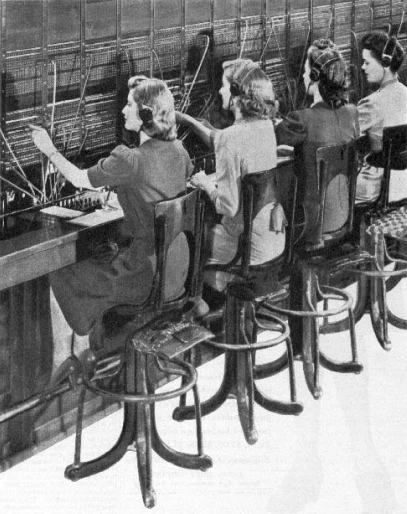
Switchboard operation was a feminized profession for many reasons, the most important being the perception that women’s affect suited the even keel and moral upstanding needed of operators, who were supposed to be discreet while routing calls, which they could hear through their headsets. [2] Though women were discouraged from listening in on calls while they were working, many did. In an anonymous 1907 article in the Saturday Evening Post, an American switchboard operator wrote of the joyful mischief she found by discreetly listening in.
‘It’s so queer to press down the row of “listening keys” one after another and get bits of the different conversations! Different voices, different dialects, different emotions, tempers, subjects! All sliced off like Neapolitan ice cream—little bits of pulsing human lives. The girls do awfully mean things when they’re exasperated by angry subscribers. You can, for instance, switch three or four couples together—a pair of lovers, maybe, two business men and one woman gossiping to another—and then sit and hear them rage at each other.’ [3]
I love this operator’s description of her trouble making as queer. In 1907, this word was on the verge of becoming a slur for “homosexual,” but still meant something more like strange, odd, or eccentric, albeit inflected by ideas about sexuality and stigma. By naming as queer her clandestine efforts to listen in on calls and deliberately misdirect callers into unexpected relations with strangers, this operator gets at the peculiar intimacies produced by telephone talk: the simultaneous feeling of being at a distance produced by the phone’s mediation, alongside the weird closeness of hearing another person’s voice and breath right in your ear; or the discomfiting public nature of calling through a human operator to speak to your lover or friend about private things.
The switchboard as a metaphor for women working with the phone persisted long after automation replaced human switchboard operators. In previous work I’ve written at length about New York City’s Lesbian Switchboard, a volunteer-run telephone hotline that operated from the 1970s through 1990s, answering calls from lesbians in need. Night after night, a single volunteer sat in a small office at the local gay and lesbian community centre, in front of a regular handset. She answered calls about where to find a lesbian-friendly therapist or what bars to visit, and gave advice about coming out and relationships. Each of these calls was logged briefly but meticulously in a spiral-bound notebook, leaving behind an archive that is plentiful in some ways, but unable to account for the cadence and feeling exchanged through decades of telephone talk. The choice to call this hotline a “switchboard” locates this caring work in a longer legacy of what the telephone has meant to women’s networks and labour.
In all these scenarios of telephone talk, the bell, buzz, or ring are summons: an invitation to work, gossip, or give support by stepping outside of oneself into a wider network held together by the telephone.
- Lana F. Rakow, Gender on the Line: Women, the Telephone, and Community Life (Urbana and Chicago: University of Illinois Press, 1992, 5.
- Michèle Martin, “Feminisation of the Labour Process in the Communication Industry: The Case of the Telephone Operators, 1876-1904,” Labour/Le Travail 22 (1988): 139–62.
- Quoted in Jeff Nilsson, “What the Operators Overheard in 1907, Saturday Evening Post, 30 June 2012, saturdayeveningpost.com/2012/06/operators-heard-1907.

Installation view of The Lips of History, objects courtesy of the Houweling Telecommuseum. Photo: Gunnar Meier.

Installation view of The Lips of History. Photo: Gunnar Meier.

Bia Davou, [Newspaper collage], 1991, mixed media collages, each 39.2 x 29.2cm. Photo: Gunnar Meier.

Bia Davou, Untitled (ΚΑΖΑΝΘ), 1973, marker, Letraset, pencil on cardboard, 23.5 x 19cm, and Untitled, 1975, paper tape, Letraset, pencil on watercolour paper, 60 x 30cm. Photo: Gunnar Meier.
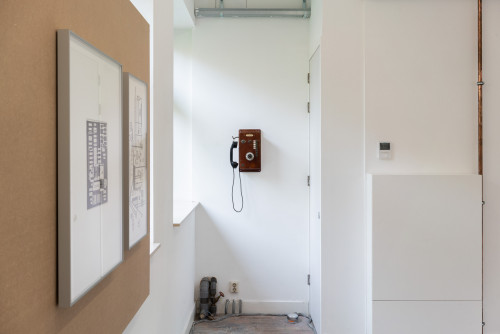
Installation view of The Lips of History, object on loan from the Houweling Telecommuseum. Photo: Gunnar Meier.
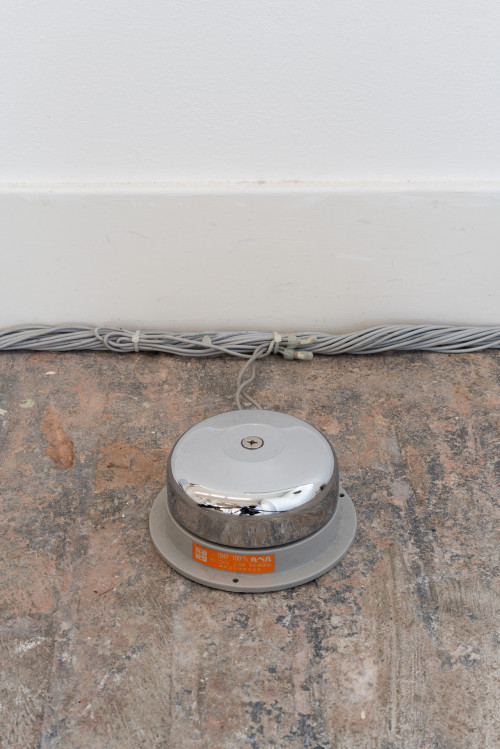
Atsuko Tanaka, Work (Bell), 1955/1993, twenty bells, wire, motor and switch, dimensions variable, length of wire approximately 40m. Photo: Gunnar Meier.

Installation view of The Lips of History, featuring Olga Micińska, Workdesks, 2024, wood, set of tables and stools, site specific and Hazel Meyer and Cait McKinney, The Images, such as they are, do have an effect on us, 2022, paper, copies, photos, clips, staples, envelopes, postage, edition of 100, distributed via Canada Post, 24 x 30.5cm, exhibited on Workdesks. Photo: Gunnar Meier.
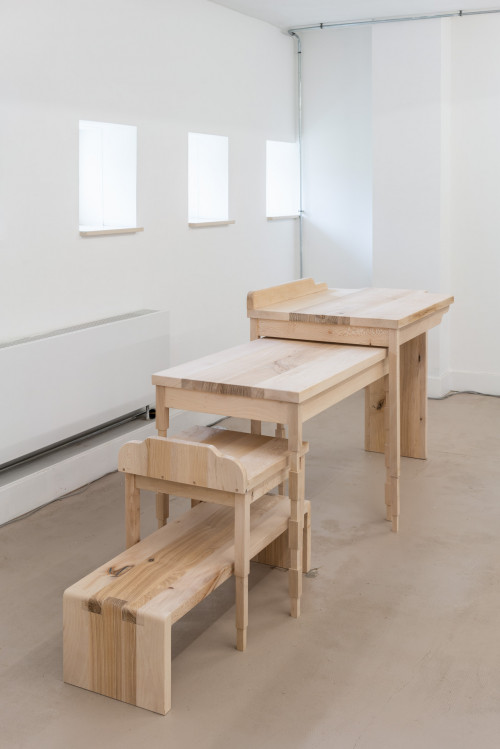
Olga Micińska, Nesting group, 2024, wood, 76 x 60 x 89cm, expandable. This work has been made with help of Maria Ostaszewska-Cichocka and Sophia Simensk.
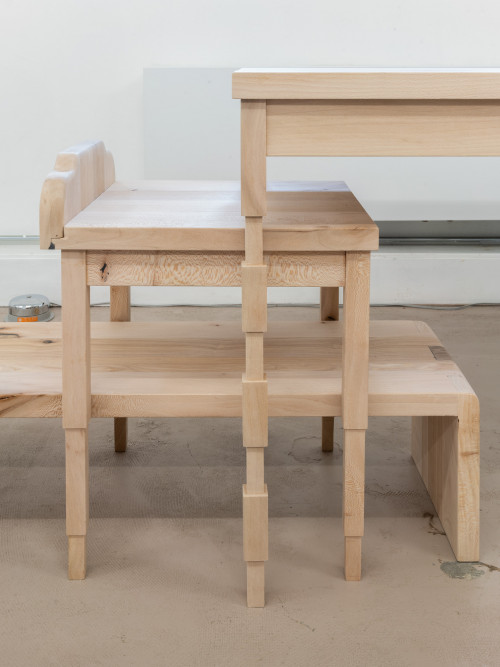
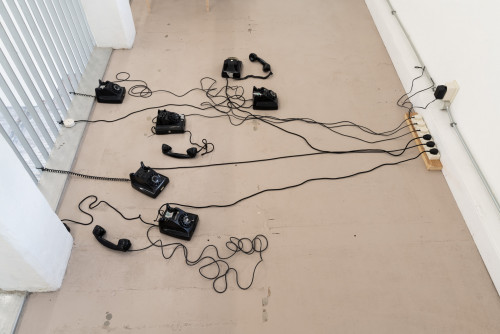
Pelumi Adejumo, The Moaner/De hijger, 2024, six-channel sound installation, repurposed telephones from the Houweling Telecommuseum, dimensions variable. This two-part work was installed across A Tale of A Tub and the Houweling Telecommuseum.
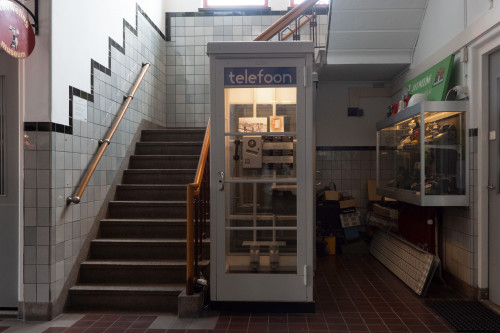
Pelumi Adejumo, The Moaner/De hijger, 2024, six-channel sound installation, repurposed telephones from the Houweling Telecommuseum, dimensions variable. This two-part work was installed across A Tale of A Tub and the Houweling Telecommuseum. Photo: Erika Roux.

Pelumi Adejumo, The Moaner/De hijger, 2024, six-channel sound installation, repurposed telephones from the Houweling Telecommuseum, dimensions variable. This two-part work was installed across A Tale of A Tub and the Houweling Telecommuseum. Photo: Erika Roux.

Pelumi Adejumo, The Moaner/De hijger, 2024, six-channel sound installation, repurposed telephones from the Houweling Telecommuseum, dimensions variable. This two-part work was installed across A Tale of A Tub and the Houweling Telecommuseum. Photo: Erika Roux.

Hazel Meyer and Cait McKinney, The Images, such as they are, do have an effect on us, 2022, paper, copies, photos, clips, staples, envelopes, postage, edition of 100, distributed via Canada Post, 24 x 30.5cm. Photo: Gunnar Meier.

Various materials on loan from the Houweling Telecommuseum, Rotterdam, including
cable parts and ends, a manual exchange, candlestick telephone, bells, telephone directory (from Stadhuis Rotterdam), sea cable with fishing net (pictured here). Photo: Gunnar Meier.
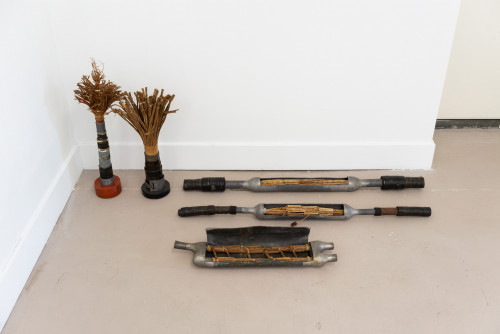
Cable parts and ends on loan from the Houweling Telecommuseum. Photo: Gunnar Meier.
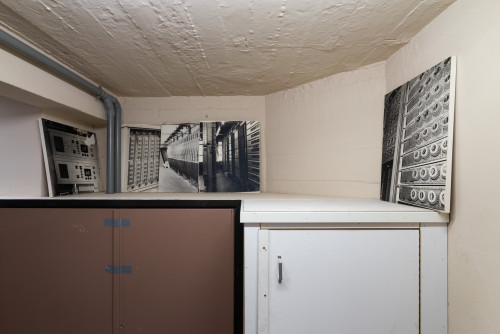
Archival photographs of the Houweling Telecommuseum when in operation as a telephone exchange, including of cable cabinets, a power convertor, rotating selectors and the cable cellar. Photo: Gunnar Meier.

Hazel Meyer and Cait McKinney, Slumberparty, 2018, 2018, video, 25:33mins. Photo: Gunnar Meier.

Installation view of Kirsten Pieroth, Antenna System for the First Transatlantic Transmission in 1901, 2009, three tables, sand, string, steel, dimensions variable, and Kirsten Pieroth, Marconi’s Early Experiments in Communicating, 2009, series of six Inkjet prints, partly collaged, each 36 x 52cm. Photo: Gunnar Meier.

Kirsten Pieroth, Antenna System for the First Transatlantic Transmission in 1901, Before the Storm, 2009, three tables, sand, string, steel, dimensions variable. Photo: Gunnar Meier.
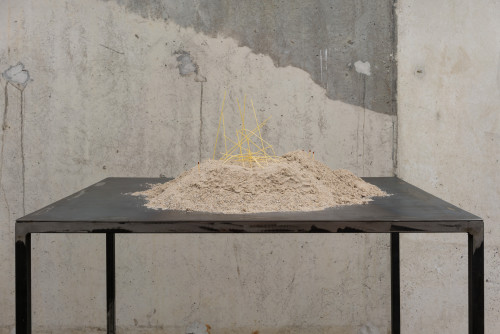
Kirsten Pieroth, Antenna System for the First Transatlantic Transmission in 1901, After the Storm, 2009, three tables, sand, string, steel, dimensions variable. Photo: Gunnar Meier.

Kirsten Pieroth, Antenna System for the First Transatlantic Transmission in 1901, Temporary Antenna, 2009, three tables, sand, string, steel, dimensions variable. Photo: Gunnar Meier.

Kirsten Pieroth, Marconi’s Early Experiments in Communicating, 2009, series of six Inkjet prints, partly collaged, each 36 x 52cm. Photo: Gunnar Meier.

Detail of Kirsten Pieroth, Marconi’s Early Experiments in Communicating, 2009, series of six Inkjet prints, partly collaged, each 36 x 52cm. Photo: Gunnar Meier.

Kirsten Pieroth, Untitled (The Wall Street Journal), 2015, twenty-six jars, liquids from boiled newspapers, overall length approximately 230cm. Photo: Gunnar Meier.

Detail of Kirsten Pieroth, Untitled (The Wall Street Journal), 2015, twenty-six jars, liquids from boiled newspapers, overall length approximately 230cm. Photo: Gunnar Meier.

